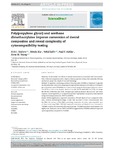Poly(propylene glycol) and urethane dimethacrylates improve conversion of dental composites and reveal complexity of cytocompatibility testing
| dc.contributor.author | Walters, NJ | |
| dc.contributor.author | Xia, W | |
| dc.contributor.author | Hagen, Chris | |
| dc.contributor.author | Ashley, PF | |
| dc.contributor.author | Young, AM | |
| dc.date.accessioned | 2017-01-10T15:55:41Z | |
| dc.date.accessioned | 2017-01-10T16:21:12Z | |
| dc.date.available | 2017-01-10T15:55:41Z | |
| dc.date.available | 2017-01-10T16:21:12Z | |
| dc.date.issued | 2016-02 | |
| dc.identifier.issn | 0109-5641 | |
| dc.identifier.issn | 1879-0097 | |
| dc.identifier.uri | http://hdl.handle.net/10026.1/8231 | |
| dc.description.abstract |
OBJECTIVES: To determine the effects of various monomers on conversion and cytocompatibility of dental composites and to improve these properties without detrimentally affecting mechanical properties, depth of cure and shrinkage. METHODS: Composites containing urethane dimethacrylate (UDMA) or bisphenol A glycidyl methacrylate (Bis-GMA) with poly(propylene glycol) dimethacrylate (PPGDMA) or triethylene glycol dimethacrylate (TEGDMA) were characterized using the following techniques: conversion (FTIR at 1 and 4mm depths), depth of cure (BS EN ISO 4049:2009 and FTIR), shrinkage (BS EN ISO 17304:2013 and FTIR), strength and modulus (biaxial flexural test) and water sorption. Cytocompatibility of composites and their liquid phase components was assessed using three assays (resazurin, WST-8 and MTS). RESULTS: UDMA significantly improved conversion, BFS and depth of cure compared to Bis-GMA, without increasing shrinkage. UDMA was cytotoxic at lower concentrations than Bis-GMA, but extracts of Bis-GMA-containing composites were less cytocompatible than of those containing UDMA. PPGDMA improved conversion and depth of cure compared to TEGDMA, without detrimentally affecting shrinkage. TEGDMA was shown by all assays to be highly toxic. Resazurin, but not WST-8 and MTS, suggested that PPGDMA exhibited improved cytocompatibility compared to TEGDMA. SIGNIFICANCE: The use of UDMA and PPGDMA results in composites with excellent conversion, depth of cure and mechanical properties, without increasing shrinkage. Composites containing UDMA appear to be slightly more cytocompatible than those containing Bis-GMA. These monomers may therefore improve the material properties of dental restorations, particularly bulk fill materials. The effect of diluent monomer on cytocompatibility requires further investigation. | |
| dc.format.extent | 264-277 | |
| dc.format.medium | Print-Electronic | |
| dc.language | en | |
| dc.language.iso | eng | |
| dc.publisher | Elsevier BV | |
| dc.relation.replaces | http://hdl.handle.net/10026.1/8228 | |
| dc.relation.replaces | 10026.1/8228 | |
| dc.subject | Dental composite | |
| dc.subject | Dental material | |
| dc.subject | Monomer | |
| dc.subject | Cytocompatibility | |
| dc.subject | Degree of conversion | |
| dc.subject | Polymerization shrinkage | |
| dc.subject | PPGDMA | |
| dc.subject | TEGDMA | |
| dc.subject | UDMA | |
| dc.subject | Bis-GMA | |
| dc.title | Poly(propylene glycol) and urethane dimethacrylates improve conversion of dental composites and reveal complexity of cytocompatibility testing | |
| dc.type | journal-article | |
| dc.type | Journal Article | |
| dc.type | Research Support, Non-U.S. Gov't | |
| plymouth.author-url | https://www.webofscience.com/api/gateway?GWVersion=2&SrcApp=PARTNER_APP&SrcAuth=LinksAMR&KeyUT=WOS:000370808400019&DestLinkType=FullRecord&DestApp=ALL_WOS&UsrCustomerID=11bb513d99f797142bcfeffcc58ea008 | |
| plymouth.issue | 2 | |
| plymouth.volume | 32 | |
| plymouth.publication-status | Published | |
| plymouth.journal | Dental Materials | |
| dc.identifier.doi | 10.1016/j.dental.2015.11.017 | |
| plymouth.organisational-group | /Plymouth | |
| plymouth.organisational-group | /Plymouth/Faculty of Health | |
| plymouth.organisational-group | /Plymouth/Faculty of Health/Peninsula Dental School | |
| plymouth.organisational-group | /Plymouth/REF 2021 Researchers by UoA | |
| plymouth.organisational-group | /Plymouth/REF 2021 Researchers by UoA/UoA03 Allied Health Professions, Dentistry, Nursing and Pharmacy | |
| plymouth.organisational-group | /Plymouth/Research Groups | |
| plymouth.organisational-group | /Plymouth/Research Groups/Institute of Translational and Stratified Medicine (ITSMED) | |
| plymouth.organisational-group | /Plymouth/Research Groups/Institute of Translational and Stratified Medicine (ITSMED)/CBR | |
| plymouth.organisational-group | /Plymouth/Users by role | |
| plymouth.organisational-group | /Plymouth/Users by role/Academics | |
| dc.publisher.place | England | |
| dcterms.dateAccepted | 2015-11-30 | |
| dc.identifier.eissn | 1879-0097 | |
| dc.rights.embargoperiod | No embargo | |
| rioxxterms.funder | Engineering and Physical Sciences Research Council | |
| rioxxterms.identifier.project | Re-mineralising, antibacterial composites and adhesives for more durable, conservative and pain less tooth restoration | |
| rioxxterms.versionofrecord | 10.1016/j.dental.2015.11.017 | |
| rioxxterms.licenseref.uri | http://www.rioxx.net/licenses/all-rights-reserved | |
| rioxxterms.licenseref.startdate | 2016-02 | |
| rioxxterms.type | Journal Article/Review | |
| plymouth.funder | Re-mineralising, antibacterial composites and adhesives for more durable, conservative and pain less tooth restoration::Engineering and Physical Sciences Research Council |


